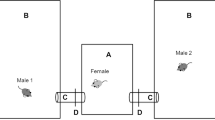Abstract
Artificial selection was used to establish different levels of agonistic behavior in laboratory-reared wild femaleMus musculus. A within-family selection design with replicated high and low lines and two nonselected control lines was employed. Females only were tested at 8 weeks of age on 2 consecutive days. Testing consisted of placing a C57BL/6 female mouse in the home cage of the isolation-reared wild mouse for 7 min or until an attack occurred. The wild females were rated on a 5-point scale for agonistic behavior, and the sum of the scores over the 2 test days was the criterion for selection. The six lines, each containing ten breeding pairs, were selected for four generations. By the fourth selected generation, the responses of the high and low lines had diverged in the expected directions. One-way analyses of variance indicated reliable differences among high, low, and control lines in the second, third, and fourth generations. It was concluded that female agonistic behavior is influenced by genotype and that the level of this behavior can be manipulated by means of artificial selection.
Similar content being viewed by others
References
Dawson, W. M. (1932), Inheritance of wildness and tameness in mice.Genetics 17:297–326.
DeFries, J. C. (1967). Quantitative genetics and behavior: Overview and perspective. In Hirsch, J. (ed.),Behavior Genetic Analysis, McGraw-Hill, New York.
Ebert, P. D. (1972). Agonistic behavior in wild and inbred mice. Unpublished master's thesis, Bowling Green State University.
Falconer, D. S. (1960).Introduction to Quantitative Genetics, Ronald Press, New York.
Fredericson, E. (1952). Aggressiveness in female mice.J. Comp. Physiol. Psychol. 45:254–257.
Gandelman, R. (1972). Mice: Postpartum aggression elicited by the presence of an intruder.Horm. Behav. 3:23–28.
Lagerspetz, K. (1964). Studies on the aggressive behavior of mice.Ann. Acad. Sci. Fenn. (B) 131:1–131.
McClearn, G. E., and DeFries, J. C. (1973).Introduction to Behavioral Genetics, Freeman, San Francisco.
Scott, J. P. (1966). Agonistic behavior of mice and rats: A review.Am. Zoologist 6:683–701.
Smith, R. H. (1972). Wildness and domestication inMus musculus: A behavioral analysis.J. Comp. Physiol. Psychol. 79:22–29.
St. John, R. D., and Corning, P. A. (1973). Maternal aggression in mice.Behav. Biol. 9:635–639.
Weltmann, A. S., Sackler, A. M., Schwartz, R., and Owens, H. (1968). Effects of isolation stress on female albino mice.Lab. Anim. Care 18:426.
Weltman, A. S., Sackler, A. M., Schwartz, R., and Owens, H. (1970). Maternal effects on behavior and white blood cells of isolated female mice.Life Sci. 9:291–300.
White, M., Smith, M., and Edwards, D. A. (1969). Fighting in female mice as a function of the size of the opponent.Psychon. Sci. 16:14–15.
Author information
Authors and Affiliations
Rights and permissions
About this article
Cite this article
Ebert, P.D., Hyde, J.S. Selection for agonistic behavior in wild femaleMus musculus . Behav Genet 6, 291–304 (1976). https://doi.org/10.1007/BF01065725
Received:
Accepted:
Issue Date:
DOI: https://doi.org/10.1007/BF01065725




